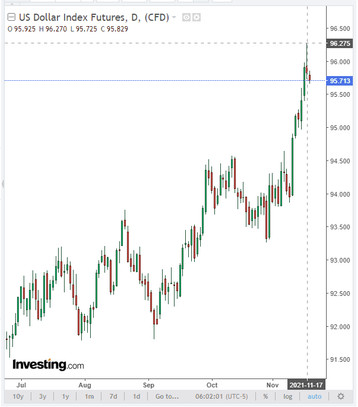Despite the drop in the volume of commercial oil reserves in the US, oil prices dropped significantly last Wednesday. According to data published on Wednesday by the Energy Information Administration (EIA) of the US Department of Energy, oil reserves in the week of November 6-12 fell by 2.1 million barrels, to 433 million barrels, instead of the expected growth of 1.398 million barrels and after an increase of 1.001 million barrels in the previous reporting period. Now the volume of oil reserves in the United States is about 7% below the average 5-year value, noted in the EIA. At the same time, gasoline inventories fell by 707,000 barrels to 212 million barrels, which also turned out to be stronger than the forecast for a reduction of 600,000 barrels.
At the same time, US oil production fell by 11.4 million barrels from 11.5 million barrels per day, according to the EIA.
However, this really positive news failed to support oil prices.
Last Wednesday, WTI oil prices fell by 2.9% to $ 77.18 per barrel, and the cost of a barrel of Brent crude oil fell by 2.4% to $ 79.34.
There is also a slight decline in prices today after yesterday's fall. So, at the time of publication of this article, WTI futures are traded near the mark of $ 77.15 per barrel, $ 0.18 below the opening price of today's trading day.
In addition to the strong position of the dollar, pressure on prices was exerted by media reports that the US government is negotiating with Japan, South Korea, India and China, discussing the possibility of jointly selling part of its strategic reserves in the market in order to stem the rise in prices and provide support for the global economic recovery.
According to The South China Morning Post, the US has offered China to use its strategic oil reserves to lower international oil prices. The topic was reportedly discussed at the Biden-Xi virtual summit on Monday evening.
In addition, yesterday, the Minister of Energy of the United Arab Emirates, Suhail al-Mazrui, announced the possibility of reducing the shortage of oil supplies to the market in the first quarter of 2022.
Meanwhile, oil market analysts do not expect a further and stronger decline in prices. So, according to them, oil reserves in the United States are more than 11% lower than a year ago, and the volume of oil production in the country remains at the same levels, more than 1.5 million barrels per day lagging behind the maximum production levels in the period before the pandemic. Oil market analysts also suggest that prices may rise even more next year, approaching the range of $ 90-100 per barrel. Their forecast is based on strong demand amid the ongoing recovery of the global economy, increased international traffic, a shortage of natural gas and continued OPEC+ production restrictions.
Meanwhile, the dollar index is mostly holding its previously won positions, staying in the area of the 16-month high, reached on Tuesday near the mark of 96.27. As of this posting, DXY futures are traded near 95.71.

The dollar continues to receive support from published last week's consumer price index (CPI), which was further evidence that inflation in the United States is high and growing, including on the sentiment of Fed leaders, who are gradually leaning towards an earlier start the interest rates increase.
Inflationary expectations of US consumers for the next 12 months rose to 4.9% from 4.8% in October and is 2.9% for the next five years. In view of this, according to economists, the dollar will remain strong due to strengthening expectations for an increase in the US key interest rate, and market participants are betting on further strengthening of the dollar, expecting a more rapid tightening of the Fed's monetary policy after the release of strong inflation data.
Today, market participants will pay attention to the publication (at 13:30 GMT) of the weekly data of the US Department of Labor. According to the previous report, the number of initial applications for unemployment benefits fell to 267 thousand compared to 271 thousand a week earlier, which is in line with pre-crisis levels. In the week before November 5, another decrease in this indicator is expected (to 260 thousand), which will be another evidence of the ongoing recovery of the American labor market, and this is a positive factor for the dollar.
And on Friday, oil market participants will pay attention to the publication (at 18:00 GMT) of the weekly report on oil platforms from the oilfield services company Baker Hughes. Previous data from Baker Hughes reflected an increase in the number of active rigs to 454 units (versus 450, 445, 433, 428, 421, 411, 401, 394, 410, 405, 397 in previous reporting periods). It is obvious that the number of oil companies in the US is growing again, which is a negative factor for oil prices. Their next growth will also have a negative impact on oil quotes, however, it will only have a short-term character.
In general, despite yesterday's decline, oil market analysts believe that energy prices will maintain positive dynamics, trading above current levels, based on expectations of a cold winter amid a shortage of other energy resources, in particular natural gas, and limited oil supplies by OPEC+ countries.





